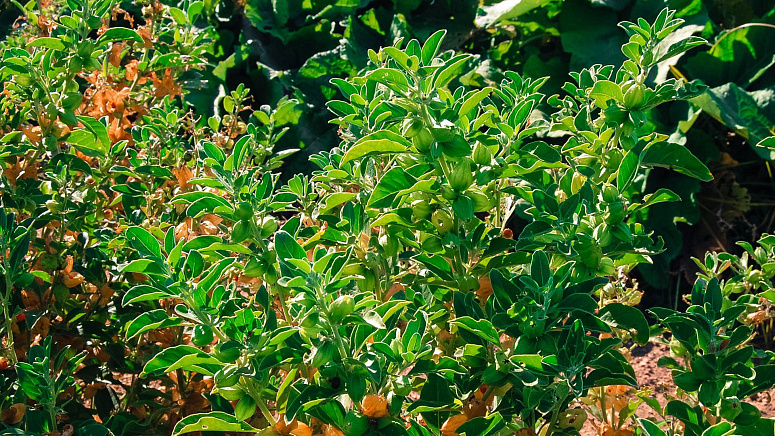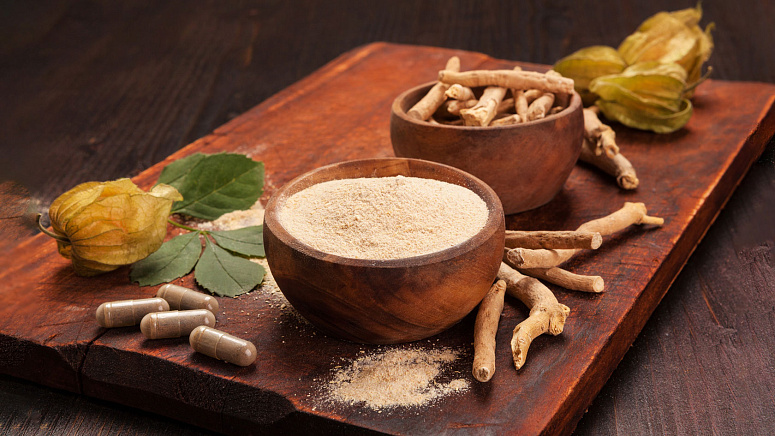Ashwagandha has been used in Eastern medicine for over 4,000 years. This plant is mentioned in Ayurvedic texts, Chinese sources, and Unani (Perso-Arabic traditional medicine). There exists evidence that African tribes used this remedy to treat inflammatory diseases and fevers.
Ashwagandha is described in two Ayurvedic treatises, the Charaka Samhita and Sushruta Samhita. The authors of these texts recommend using Ayurveda to improve elderly mental and physical health, longevity, reproductive health, and as a tonic for children.
Ashwagandha has a beneficial effect on pitta dosha and pacifies vata dosha. When applied to the body, its oil alleviates feelings of cold, dryness, muscle tension, and nervousness. Healthy, youthful skin is a particular benefit of ashwagandha.
Composition and properties of the Ayurvedic medicine ashwagandha
Ashwagandha is a small shrub with yellow flowers and red fruits. It grows in India, North Africa, and the Middle East. It is also called Withania Somnifera, “Indian ginseng,” or “winter cherry.” The word “ashwagandha” translates from Sanskrit as ‘horse scent.’ This word likely stems from the root’s odor, which resembles the smell of a horse’s sweat. Another theory holds that the plant imparts “horsepower” to its users. The Latin word “somnifera” means ‘drowsiness,’ which refers to ashwagandha’s sedative properties. The plant derives its powerful healing properties from withanolides, natural steroidal lactones found in the root.
Lowering blood sugar levels
Studies have shown that ashwagandha root powder is as effective at lowering blood sugar as medications for type 2 diabetes. This is because ashwagandha affects cortisol, which plays a significant role in regulating one’s levels of blood sugar.
Lowering cortisol levels
Stress affects our lives much more than we think. Whether it’s emotional, psychological, or physical, it involves cortisol, a stress hormone produced by the adrenal glands. Incidentally, stress can arise not only after a conflict with your boss. Chronically high cortisol levels can be caused by elevated blood sugar and weight gain.
Treating arthritis
Ashwagandha’s anti-inflammatory properties are used in the treatment of rheumatoid arthritis. Ayurvedic texts recommend turning the root into a paste and applying it to ulcers and joints to relieve inflammation. The plant can also help with other sources of inflammation. Research has found that ashwagandha root infusions increase the number of infection-fighting immune cells and reduce C-reactive protein (a protein made by the liver that increases when there’s inflammation in the body).
Improving brain function
Ashwagandha’s strengthening properties extend beyond the physical body to mental health and brain function. The remedy greatly improves cognitive function, memory, and information processing. It can potentially support brain cell formation and protect the brain from beta-amyloid, which causes damage and destruction of brain cells and is strongly linked to the progression of Alzheimer's disease.
Improving heart health
Ashwagandha lowers total cholesterol levels, LDL cholesterol , and triglycerides, the main building blocks of body fat.
Inhibiting cancer growth
This is another of ashwagandha’s potential benefits. While no human studies have definitively proved the plant’s anti-cancer properties, there are some promising animal studies worth mentioning. The results of these studies showed that withaferin A, a natural steroidal compound, makes cancer cells less resistant to apoptosis (cell death) and slows their growth.
Another interesting study on ashwagandha and alcohol compatibility found that the plant reduces alcohol dependence and withdrawal symptoms.
Recommended uses for ashwagandha
In Ayurveda, ashwagandha is considered a grounding, calming, and restorative herb. Its effect depends on the time and form in which it’s taken. Taking it in the morning, in the form of ashwagandha tea or tablets, will ensure an active day. If you take it before bed (with milk, as tea or as tablets), your sleep will be deep, peaceful, and restore your natural energy.
Ashwagandha powder (churna) is the main component in all related remedies. To prepare churna, the plant roots are dried, chopped, and sifted. They are then used to make a decoction or powder, washed down with milk or water.
Tea made from ashwagandha roots is the best drink for sleep. To prepare it, you must boil the roots in water.
Ashwagandha tablets are the easiest and most convenient way to take the medicine. To support your wellbeing, take one tablet twice daily.
Ashwagandha oil helps with arthritis and relieves muscle tension after exercise.
Ashwagandha also has powerful anti-aging properties. A special combination of ingredients moistens, soothes, and protects the skin, making this plant the ideal remedy for aging.
Contraindications for the use of ashwagandha
- Children under 18 years of age.
- Pregnancy and lactation.
- Allergic reaction or individual intolerance to any of the ingredients.
- Combined use with certain medications (sedatives, antidepressants, immunosuppressants), or the use of any other medications on a daily basis.
- Medical conditions such as diabetes, autoimmune diseases, hyperthyroidism, exacerbation of gastritis, stomach ulcers, and kidney or liver failure.
- Upcoming surgery. Discontinue use of any product containing ashwagandha at least two weeks in advance to avoid issues with drug interactions.
Before using ashwagandha, please carefully read the instructions and consult your doctor.

